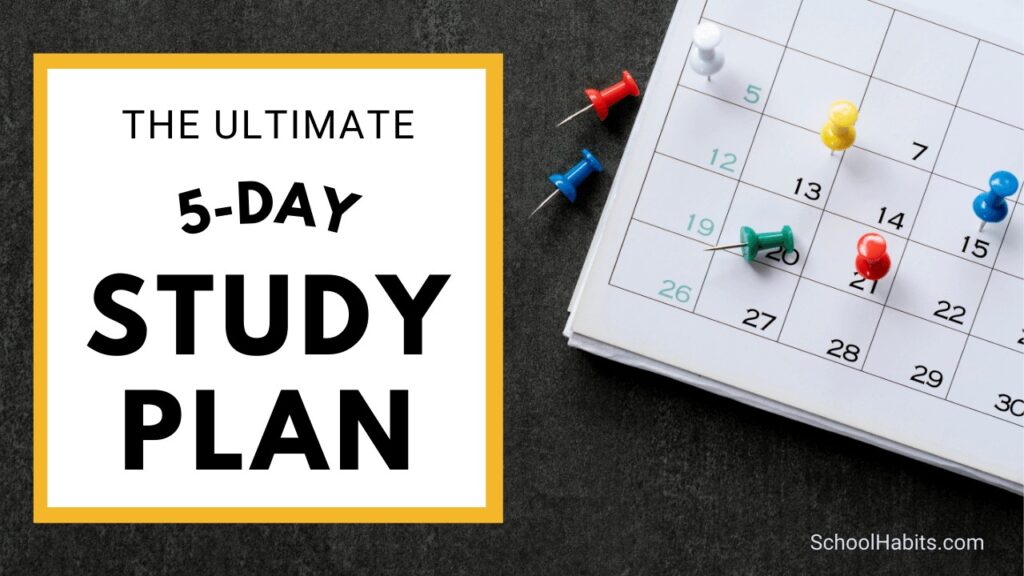
By Katie Azevedo, M.Ed.
Here’s the scenario: On a Monday, your teacher tells you there will be a test on Friday. Knowing it’s “only Monday,” you won’t even think about the test until Wednesday, at which point you tell yourself I’ll just study tomorrow.
But then tomorrow comes – which is the night before the test – and suddenly you’re overwhelmed with other homework, don’t know what to study, and feel paralyzed with anxiety as you simply read through your notes, falsely believing you are studying.
You know about this scenario, don’t you? You’ve been in this exact same situation … perhaps multiple times … am I right?
Before I get further into this post, let me lead with a golden nugget: The moment you find out you’re having a test, kick your study plan into gear.
In this tutorial, I’m sharing a 5-day study plan that you can use any time you have a test that’s five days away.
Disclaimer: I argue that preparing for a typical test over a two-week span is the ideal amount of time to study, as one of the most effective study methods called spaced repetition requires a good chunk of time.
The 5-day study plan
Before we begin, I highly suggest you download and use my free Study Planner Template.
Whether it’s currently Monday and your test is on Friday, or it’s currently Friday and your test is next Tuesday, you can use the following 5-day study plan to map out your test preparation.
Again, it’s worth repeating that the best study plans are longer than five days. However, you won’t always have more than five days’ notice before a test, and that’s when this shortened study plan can be helpful.
Day 1: Gather and consolidate (30 minutes)
Your whole objective on Day 1 is to gather and consolidate your materials for studying. Many people skip this step, but it’s very important that you don’t. There are three goals for Day 1:
- Figure out what’s on the test. This information will likely come from your teacher. If you don’t know exactly what the test is on, you won’t be able to study properly.
- Gather your materials. Gather all the materials that contain the information you need to know. This might include your textbook, notes, handouts, videos, etc.
- Condense your materials. Consolidating and reducing is the goal here. Consider printing out digital materials so you have everything in one place. If your study materials are mostly online, gather all the URLs and links and put them in one document for easy access. You could also copy and paste information from various online resources (your teacher’s Google slides, online notes, websites, and sites like Kahoot/Quizlet) into one document.
Day 2: Make your study resources and begin the study process (60-90 minutes)
Now that you know what’s on the test and have gathered all your materials, it’s time to turn that information into something studyable. Now is when you make a study guide (how? step 3 in this post here), make your own quizzes using this amazing strategy, or you make analog flashcards (not digital). Making these resources yourself IS the beginning of the study process. Avoid using premade study guides and flashcards, as that’s a cheap shortcut that significantly reduces learning.
Once you make your study guide and/or flashcards, spend 20-30 minutes studying them. You should know how to study flashcards using the 3-pile method.

Days 3 and 4: Study (45-90 minutes)
If you made a study guide on Day 2, spend one or two 45-minute sessions completing your study guide using active recall. It’s fine if you only need 45 minutes, but if you need more time (because the material is difficult or there’s a lot of it), set aside two 45-minute chunks with a break in between. If you made flashcards on Day 2, spend this time testing yourself from front to back, and back to front. Consider having someone else test you as well, in order to engage the verbal modality of learning.
Continuing to study through Day 4 takes advantage of spaced repetition, the other study technique that’s just as important as active recall (which you should also be using here). You should also try using interleaved practice, another excellent study method.
The night before your exam, use these 8 ideas to maximize the prep work you’ve already done.
Day 5 (test day): Review (20-30 minutes)
Now is the time to do a final run-through of the material. Even if your test is first thing in the morning, review the material for 20-30 minutes beforehand. This is a good time to use a review tool like Quizlet or Kahoot if you want to. Want to know if you’re really ready for the test? Here’s how to know.
Variations of the 5-day study plan
If you have more than five days to study for a test, then you can still use the structure of this 5-day study plan. You would simply add more “Study” days, which in this case are days 3 and 4. You could also vary up your study techniques, using any of these study strategies here. Additionally, you could have a longer final review session (Day 5) if your test is in the evening on the final day.

